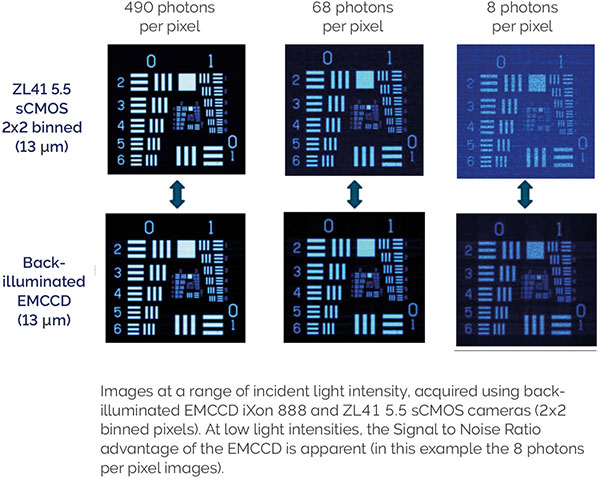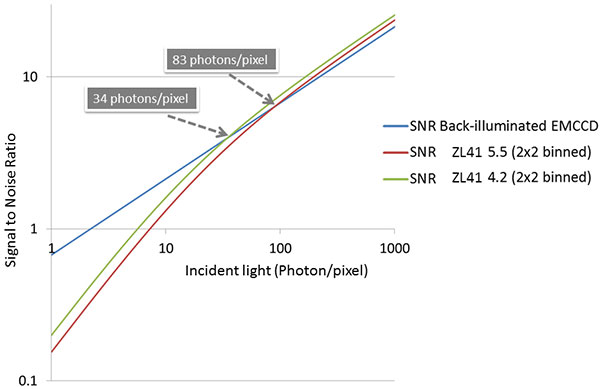Resources
 Part of the Oxford Instruments Group
Part of the Oxford Instruments Group
Expand
Collapse
 Part of the Oxford Instruments Group
Part of the Oxford Instruments Group
sCMOS cameras enable new advances and discoveries to be made due to a comprehensive set of high-performance parameters. Large, high-resolution images can be observed over fast timescales with low noise. Compared to CCD cameras, the read noise of sCMOS cameras is lower, down to 1 electron. When combined with higher resolution sensors and fast readout, sCMOS cameras are suitable for a large number of applications. Andor offer a wide range of sCMOS cameras tailored to specific applications across life and physical sciences. These include Sona, Marana, ZL41 Cell, ZL41 Wave, iStar sCMOS and Balor. See our website and spec sheets for details.
Cameras that are based on EMCCD technology are able to practically eliminate read noise making them single photon sensitive. This makes EMCCD cameras suitable for the most challenging low-light applications such as long exposure luminescence studies, single molecule detection and the lowest dye concentrations. Our EMCCD models are iXon Life and iXon Ultra. Our iXon cameras are a proven solution for many top-flight research organisations around the world exploring space, the sun, the quantum world, the fabric of life and the dynamics of disease.
Scientific CMOS (scmos) is the state-of-the-art technology for the majority of quantitative scientific measurements. It offers sharp, low noise images covering a range of energies over a wide field of view, with rapid frame rates. The read noise is exceptionally low, when compared to the highest performance CCDs. The latest Sona and Marana sCMOS cameras can achieve sensitivity at speed. The back-illuminated sensors have ~1 electron rms read noise while reading out 4.2 megapixels at up to 44 fps. Furthermore, the sensor is capable of achieving 135 full fps with a read noise of only ~1.9 electrons rms in a dedicated high speed-mode.
Greater speeds are available through selection of ‘region of interest’ sub-windows, by narrowing the field of view you can achieve higher temporal resolution. Table 1 shows frame rates that can be expected from a series of sub-window sizes in low-noise and high-speed modes. The coaXPress models provide higher data handling capacities and thus offer higher speeds at larger array sizes. This is important information for some applications that can take advantage of an elongated (letter box shape) region of interest.
| Array Size (H x V) | Low-Noise Mode USB3 [CoaXPress] Speed (fps) | High-Speed Mode USB3 [CoaXPress] Speed (fps) |
| 2046 x 2048 (full frame) | 43 [44] | 40 [135] |
| 1024 x 1024 | 87 [87] | 151 [270] |
| 512 x 512 | 174 [174] | 532 [538] |
| 256 x 256 | 346 [346] | 1046 [1081] |
| 128 x 128 | 686 [687] | 2032 [2425] |
Table 1 - Frame rate vs sub-window size. For sCMOS cameras, you can use the full row width as the full row-by-row readout of sCMOS means that speeds are dependent on row height.
Low noise readout is complemented by a high dynamic range of over 25,000:1 in Sona, Marana and ZL41 sCMOS cameras. Usually, for CCDs or EMCCDs to reach their highest dynamic range values, there needs to be a significant compromise in readout speed, yet sCMOS can achieve this value while delivering over 40fps. Furthermore, the architecture of sCMOS allows for high-dynamic range by offering a large well depth, despite the smaller pixel size.
The Electron Multiplying CCD (EMCCD) remain the most sensitive camera technology available and ideally suited to the very lowest light conditions. EMCCD cameras use an on-chip amplification mechanism called ‘Impact Ionization’ that multiplies the photoelectrons that are generated in the silicon. The signal from a single photon event can be amplified above the read noise floor, even at fast, multi-megahertz readout speeds. This makes the EMCCD capable of single photon sensitivity at fast frame rates (e.g. 26 fps with a 1024 x 1024 array). EMCCD technology is therefore ideal for demanding low light measurements, such as single molecule detection and many experiments show that the EMCCD camera will offer improved detection over any sCMOS camera.
Despite the sensitivity under extremely low light conditions, there are a few remaining drawbacks of EMCCD technology.
It is clear that for most parameters, sCMOS has a performance advantage, notably in terms of noise, speed, dynamic range and field of view/resolution. Importantly, these advantages are met largely without compromise. Whilst the read noise of sCMOS is very low, EMCCD technology can multiply the input signal above the read noise floor making it negligible (<1 e-).
Current EMCCD cameras are back-illuminated, with > 95% QE max, which increases the sensitivity. For this reason, this combination of high QE and sub-electron read noise means that EMCCD technology still holds its own in extreme low-light applications that require the highest sensitivity, providing one can sacrifice the enhanced resolution, field of view, dynamic range and frame rate that sCMOS can offer.
A comparison between sCMOS and EMCCD is shown in Table 2.
| Parameter | ZL41 Cell sCMOS | iXon-Ultra EMCCD |
| Sensor Format | 5.5 megapixel | 1.0 megapixel |
| Pixel Size | 6.5 μm | 13 μm |
| Read Noise | 0.9 @ 200MHz | < 1e- (with EM gain) |
| Full Frame Rate (max.) | Up to 100 fps | 26 |
| Quantum Efficiency (QE) | 64% | >95% |
| Dynamic Range | 33,000:1 | Dependent on readout speeds |
| Multiplicative Noise | None | 1.41x with EM gain |
Table 2 - Comparison summary of specifications of sCMOS and EMCCD technologies.

This figure gives a comparison of the resolution and signal-to-noise ratio at a range of light levels. It can be seen from the graph below that at light levels below 34 photons/pixel for the ZL41 Cell 4.2 and at 83 photons/pixel for the ZL41 Cell 5.5, the EMCCD has superior signal-to-noise.

The reason that a back-illuminated EMCCD with negligible read noise does not exhibit higher S/N right throughout the photon flux scale, is due to the multiplicative noise of the EMCCD plot (which effectively increases the shot noise).
Scientific CMOS (scmos) technology is widely regarded as an outstanding and innovative technology across a huge range of demanding imaging applications from astronomy to quantum applications, and across the life sciences from cutting edge research to patient examination (for example x-ray tomography). It can simultaneously deliver extremely low noise, fast frame rates, wide dynamic range, high quantum efficiency, high resolution and a large field of view.
For extremely low light applications that require ultra-sensitivity at the level of tens of photons per pixel and lower, at respectably fast frame rates, a high performance back illuminated EMCCD camera from the Andor iXon range can still remain the best option.
